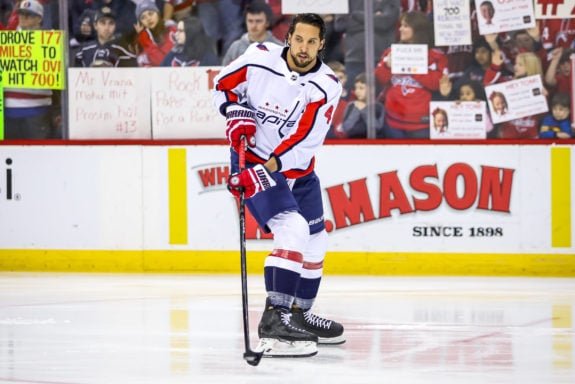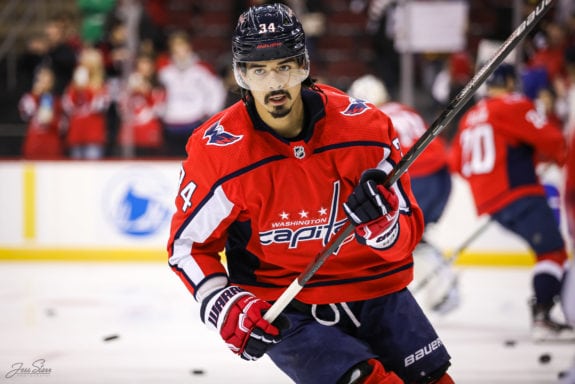In 2018, the Washington Capitals made a minor trade with the Chicago Blackhawks just prior to the trade deadline that seemed like nothing that required much analysis. Four months later they were hoisting the Stanley Cup in Las Vegas after defeating the Vegas Golden Knights 4-3 in Game 5 of the Stanley Cup Final. This caused some people to re-examine that minor deal they had made back in February.
Related: Top 3 All-Time Capitals Goalies
The deal in question was the Capitals sending a conditional third-round pick to the Blackhawks for Michal Kempny. Somehow and some way, Kempny fit right in in D.C. and was one key reason as to why the Capitals’ defense improved so drastically after the deadline and into the playoffs.

This past season, in February of 2020, just prior to the NHL Trade Deadline, the Capitals acquired another defenseman from another West Coast team. This time, they picked up Brenden Dillon of the San Jose Sharks for a second-round pick and a conditional third-round pick. It seemed like the Capitals were trying to recapture the magic they had in 2018 with Kempny, but it just didn’t work with Dillon (though he is not to blame). The Canadian-born defenseman is set to hit free agency this offseason, and despite Washington’s first-round exit to the New York Islanders, I think they should re-sign Dillon.
Why He is Worth Re-Signing
What Dillon brings to a team isn’t exactly what Quinn Hughes brings to a team. Dillon is an incredibly physical presence out on the ice at 6-foot-4 and well over 200 pounds. He was in the top 20 in the NHL in hits with 194 this past season. He is a physical presence, but not in the same way that Radko Gudas was a physical presence for the Capitals. Although Dillon will hit and fight anyone who appears to be a threat, he can play the game when he needs to.
He has some speed to him and is a defender who can control the puck. He can take the puck off the other team before making the breakout pass to start a play. Defense who can transition the puck are valuable, and Dillon is certainly capable of that.

Being the physical defenseman that he is, Dillon is also hard to knock off the puck. This is a major factor in his Corsi for percentage (CF%) being consistently positive throughout his career. He had a 51.3 CF% this past season and has a career CF% of 51.7. You can never have too many defensemen that are hard on the puck and are good at maintaining possession of it.
One thing that Dillon doesn’t provide too much of is offense. This doesn’t seem to be too big of an issue considering where the Capitals are right now. They finished the regular season with the second-most goals for in the NHL, and have a Norris Trophy finalist who scored 75 points in John Carlson. Dillon doesn’t need to be lighting the lamp to be effective on this team, he just needs to play his role.
Not to mention, Dillon has been able to play with Carlson rather perfectly (despite the postseason, which was bad for everybody, not just the two defenders). He affords Carlson the opportunity to jump up in the rush the way he likes to because Dillon will always be on the defensive side of the puck to cover for him. He seems like a perfect fit to play on that top pair with the offensive defenseman for the foreseeable future.
Another positive is that Dillon can play on the penalty kill. He was a big part of the Sharks’ penalty kill before he left, which finished first in the NHL with an 85.71% success rate. He can now be a big part of Washington’s, which was the sixth-best penalty kill in the entire NHL.
The Capitals are in dire need of competent defensemen, and Dillon provides the prototypical mould of an NHL defender. Big, strong, capable in his own end and can get the puck out of danger.
Also, an aspect that always seems to be overlooked is how he fits into the team off the ice. From what everyone has seen and heard, Dillon has seemed to fit into that locker room seamlessly. The players seem to love having him around. He is also a similar age to a lot of them at 29 years old. He isn’t a young guy trying to fit into a new locker room; he is a veteran looking to win in a room full of winning veterans.
He also became a favourite amongst fans when he got into a heated scrum with Evgeni Malkin in only his third game with the club.
The Issues With Signing Him
One issue with his game that detracts from all the good he brings is just how many penalties he takes. Dillon finished with 104 penalty minutes this past season, which was good enough for the fourth-most in the entire NHL. It isn’t something that should be taken too seriously when negotiating a contract, but it is something that needs to be worked on. It hurts your team to go down a man, but even more so when he is one of its penalty killers.
Related: Alex Ovechkin’s Milestones Through the Years
The major issue at play here is actually re-signing him. The Capitals have a projected salary cap of $8,900,123, provided they don’t re-sign Braden Holtby (which seems likely). Since 2015, Dillon has had an average annual value of $3.27 million and it seems unlikely he will be taking a pay cut on his upcoming deal. I think it is safe to say that Dillon will expect around $4 million or more for his talents. The Capitals can afford that, but it leaves them little room to re-sign other pieces that need new contracts such as Jonas Siegenthaler.

The Capitals may need to look to make a move to clear up some cap space to make their salary cap situation more flexible in case they need to sign some pieces in free agency, like possibly a backup goalie.
It won’t be the easiest task in the world, but for a team that has had some defensive struggles as of late, I think it is essential that the Capitals try to re-sign Dillon this offseason.